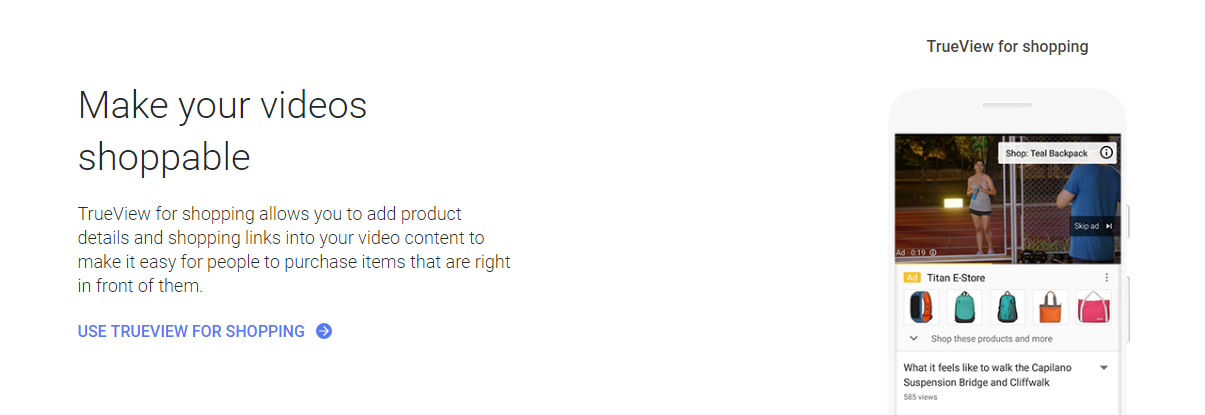If you appreciate actionable, step-by-step, go-to-market strategies that can be applied immediately or shared with clients to get them drooling with excitement, then this article is for you.
Let’s face it, the modern advertising ecosystem suffers from the law of diminishing returns.
As consumers, we get bombarded every day with ads (which are mostly irrelevant) from companies trying to convince us to buy their products, use their tools, or request their services. Most brands end up turning off the very people they hope to turn into customers.
On the other hand, as digital marketers and account executives, we have been spoiled with a plethora of digital advertising products at our fingertips. Sadly, this has led to massive waste in ad budgets, and an influx of irrelevant and down-right annoying online ad experiences as brands and ad agencies continue to "spray and pray" hoping to get lucky and acquire new customers.
So, what is the solution? How can brands ensure their ad budget is being maximized and that their ads are ALWAYS reaching the right customers who are interested in their product or service?
✅ Custom Intent Audiences ✅
And not just custom intent audiences alone, rather custom intent audiences mixed with a multi-channel retargeting strategy.
Keep reading and learn how to utilize the following
- Custom Intent Audiences + Remarketing List for Search Ads (RLSA)
- Custom Intent Audiences + Facebook Video Ads
- Custom Intent Audiences + YouTube TrueView for Action
- Custom Intent Audiences + LinkedIn Sponsored InMail
What are Custom Intent Audiences?
In a nutshell, “custom intent audiences” is a Google product that allows marketers to target people currently researching specific topics, products, and solutions on the web, using display or YouTube video ad campaigns.
People use certain keywords, visit particular pages, watch videos, and later on decide to make a purchase. Essentially, these are the people who are currently in the market for various products and services.
How to Create a Custom Intent Audience
Step 1
Click on TOOLS inside Google Ads and select Audience manager.

Step 2
Select CUSTOM AUDIENCES and click on the + button.

Step 3
Select Custom intent.

Step 4
Name your audience, select in-market keywords from the drop-down menu, and add keywords and URLs of people researching specific topics.

This saved audience can now be used for a display advertising campaign.
5 Powerful Benefits of Custom Intent Audiences
1. Custom Intent Audiences Allow You to Use Your Competitors’ First-party Data for Targeting
First-party data is the information brands collect about their audiences, such as customer names, emails, phone numbers, postal addresses, website visit data, and so on.
Do you know that by performing a simple competitive research and traffic analysis, you can gain insights into your competitors’ most visited (and most valuable pages), as well as the keywords driving traffic to those pages, which can then be used for a custom intent audience campaign?
Think about it; you are essentially targeting their website visitors without them being aware of it! This is a form of competitive conquesting. Since no company in their right minds will allow a competitor to place a banner ad on their website, the next best thing is targeting their website visitors via custom intent audiences!
In summary, you can market to their website visitors; pretty valuable if you ask me.
2. Custom Intent Audiences Allow You Market to Your Competitors’ BUYERS
Why limit retargeting efforts to just the people visiting your own website (especially if you don’t get enough traffic) when you can market to your competitors’ buyer traffic?
This is very similar to the first point above, but let me paint a clearer picture with this example:
Most companies create a “retargeting list” of people who visit individual pages on their website. Let’s use a hypothetical example with a business called ? Mary Organic Dog Treats ?.
Mary created a new organic dog treats product that dogs ABSOLUTELY LOVE, so she went ahead and launched a brand-new ecommerce store. Like most savvy businesses, she created a retargeting list of her most popular products to use for retargeting.
Her brand new website doesn’t get enough traffic to help kick start her retargeting campaign. So, what options does she have? She can begin growing a retargeting list by creating a search and shopping ads campaign. She could also target “dog lovers” on Facebook and send them to her store. Pretty standard.
But how about creating an “audience” of PROVEN, high-intent, dog treats BUYERS by leveraging the website visit data of other top dog treats brands?
Enter Custom Intent Audiences!
- Mary can leverage the product pages of popular dog brands like Chewy, Petco, PetSmart, and other large retail outlets like Walmart for her custom intent audience.
- She can take their best-selling, and most trafficked dog treats product pages and build a custom intent audience of proven shoppers to use for her targeting.
Let’s perform a simple competitive traffic analysis to identify URLs from huge brands Mary could use.
NOTE: At this point, it is essential to mention that custom intent audiences created using just URLs can only be used in a display ad campaign. However, custom intent audiences created using keywords can be used for both display and YouTube ad campaigns.
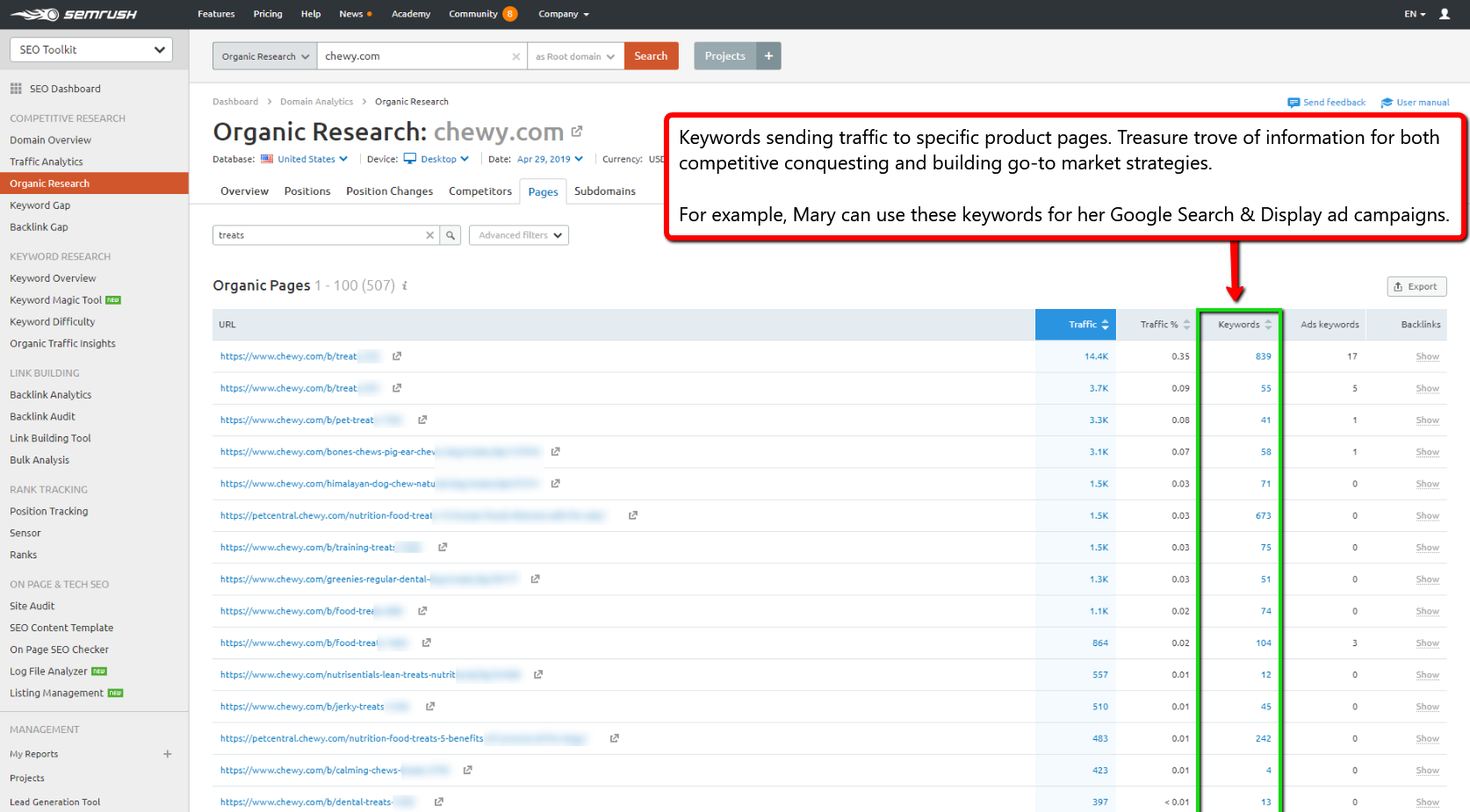
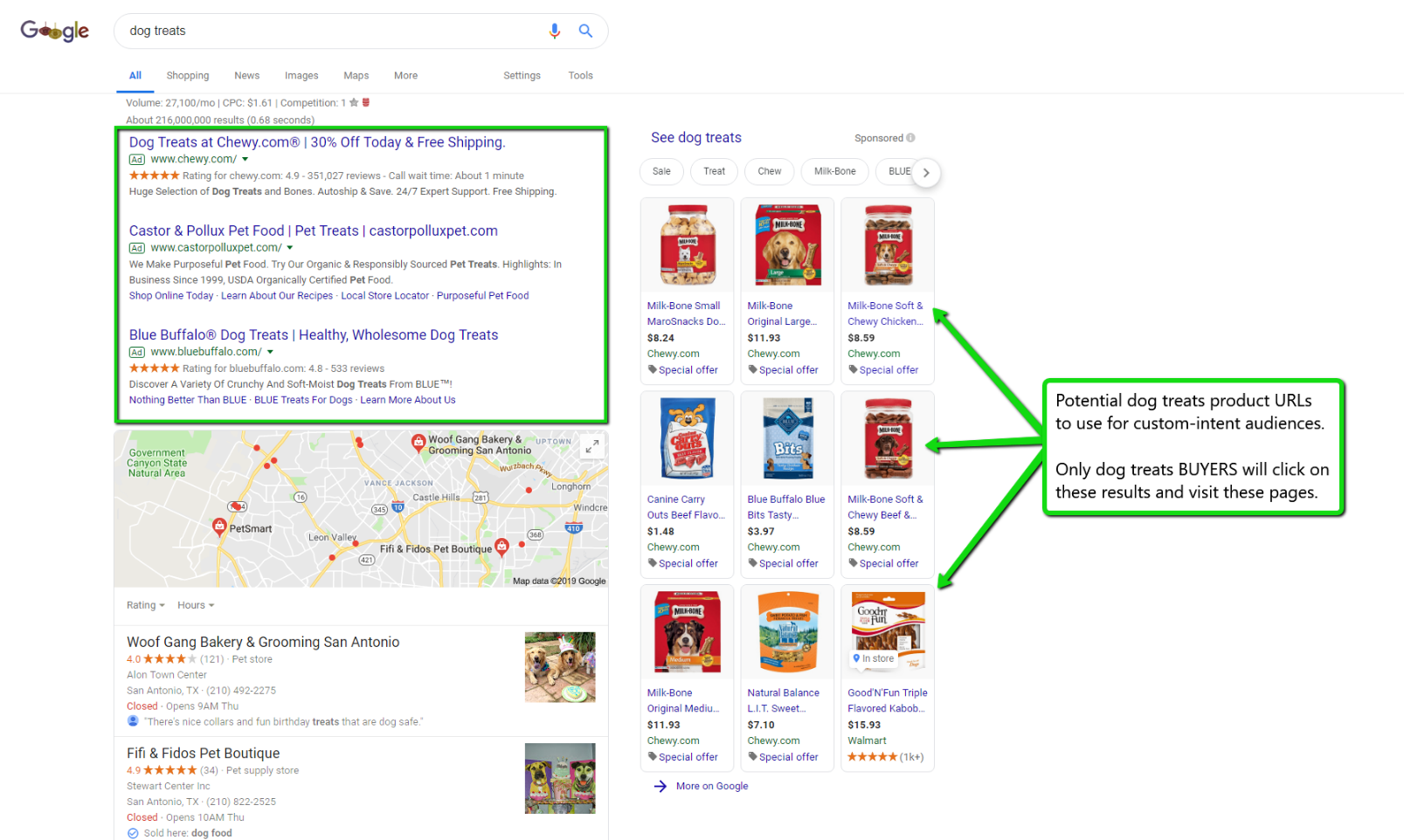
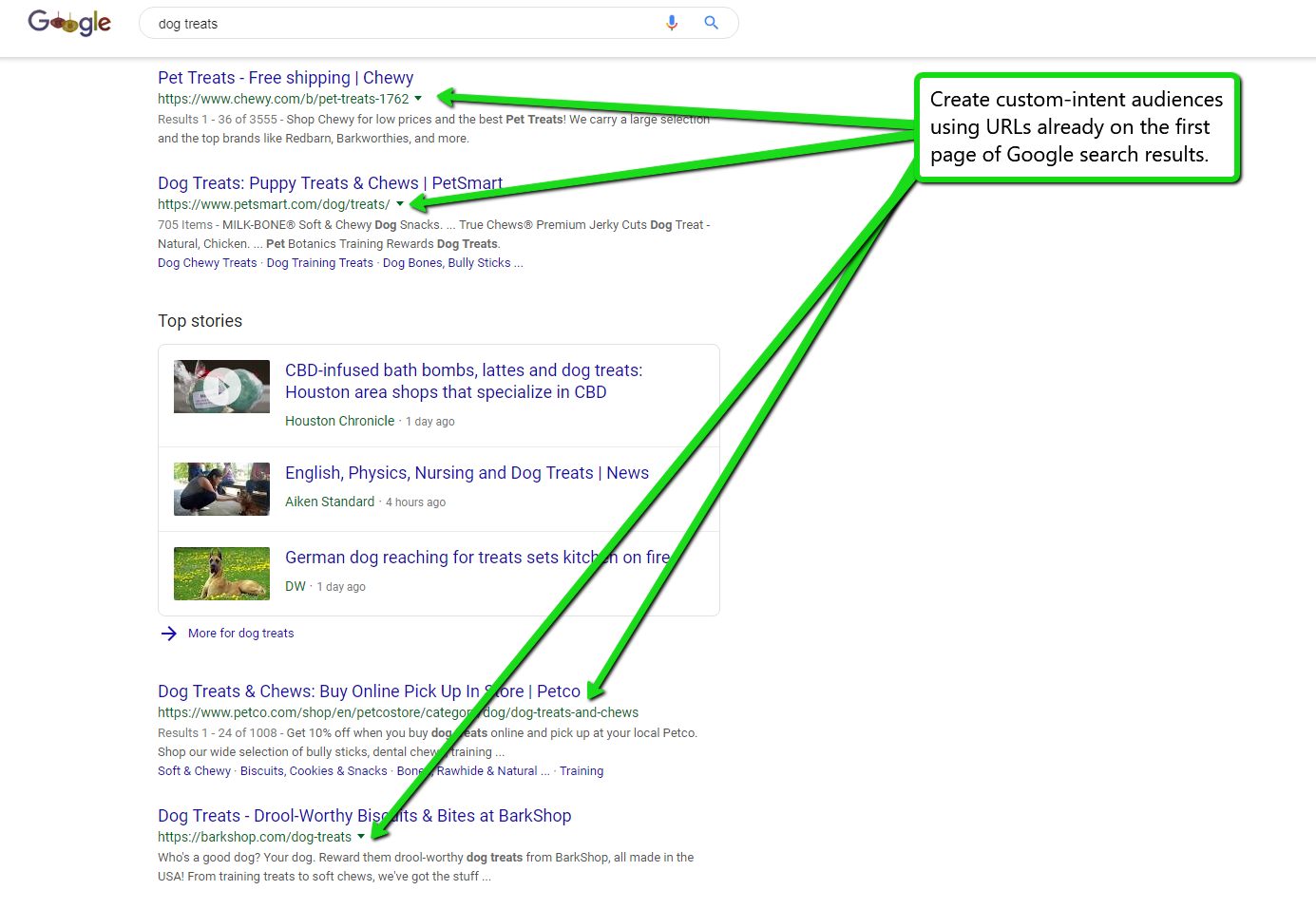
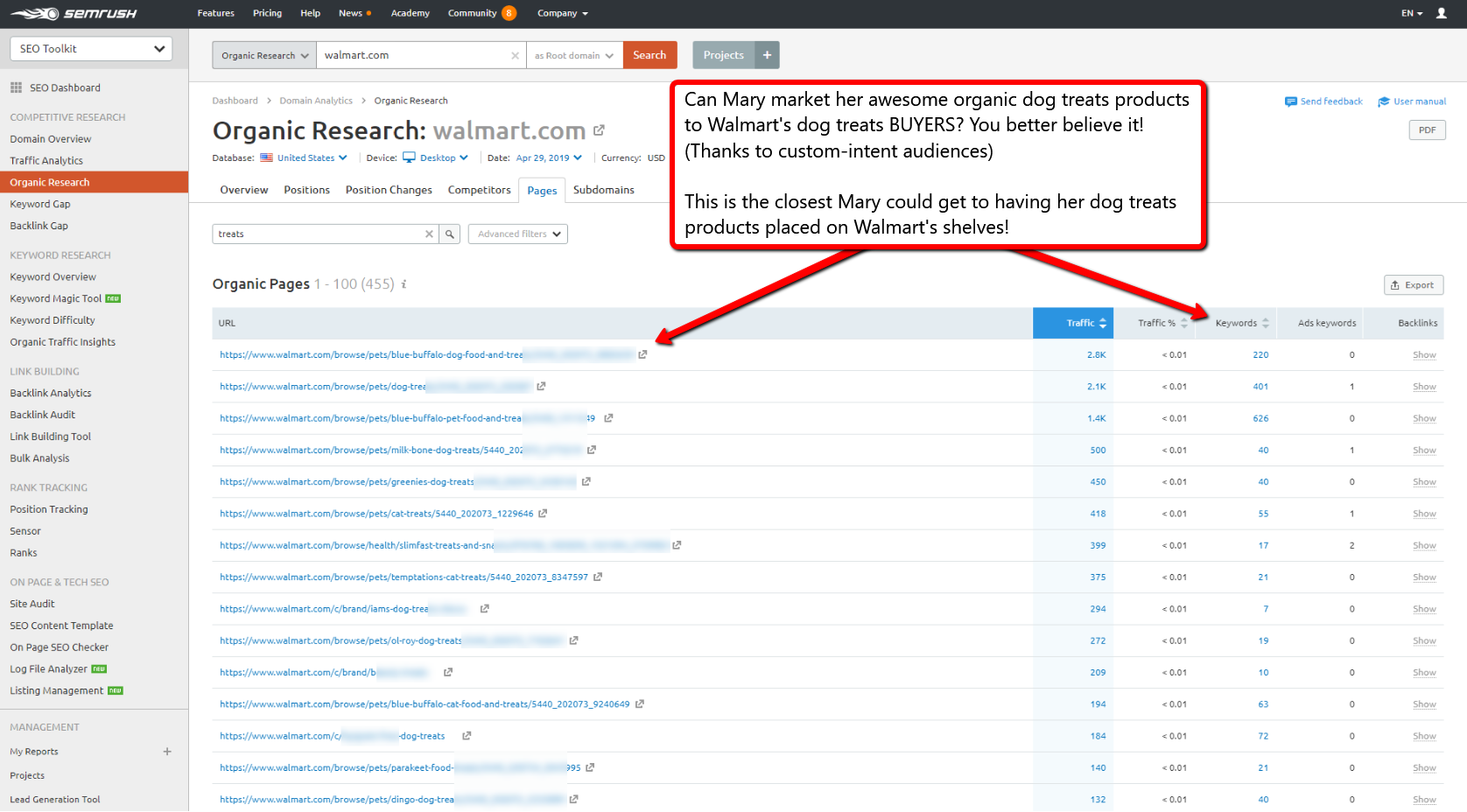
The next step is to create custom intent audiences within Google Ads using these URLs.
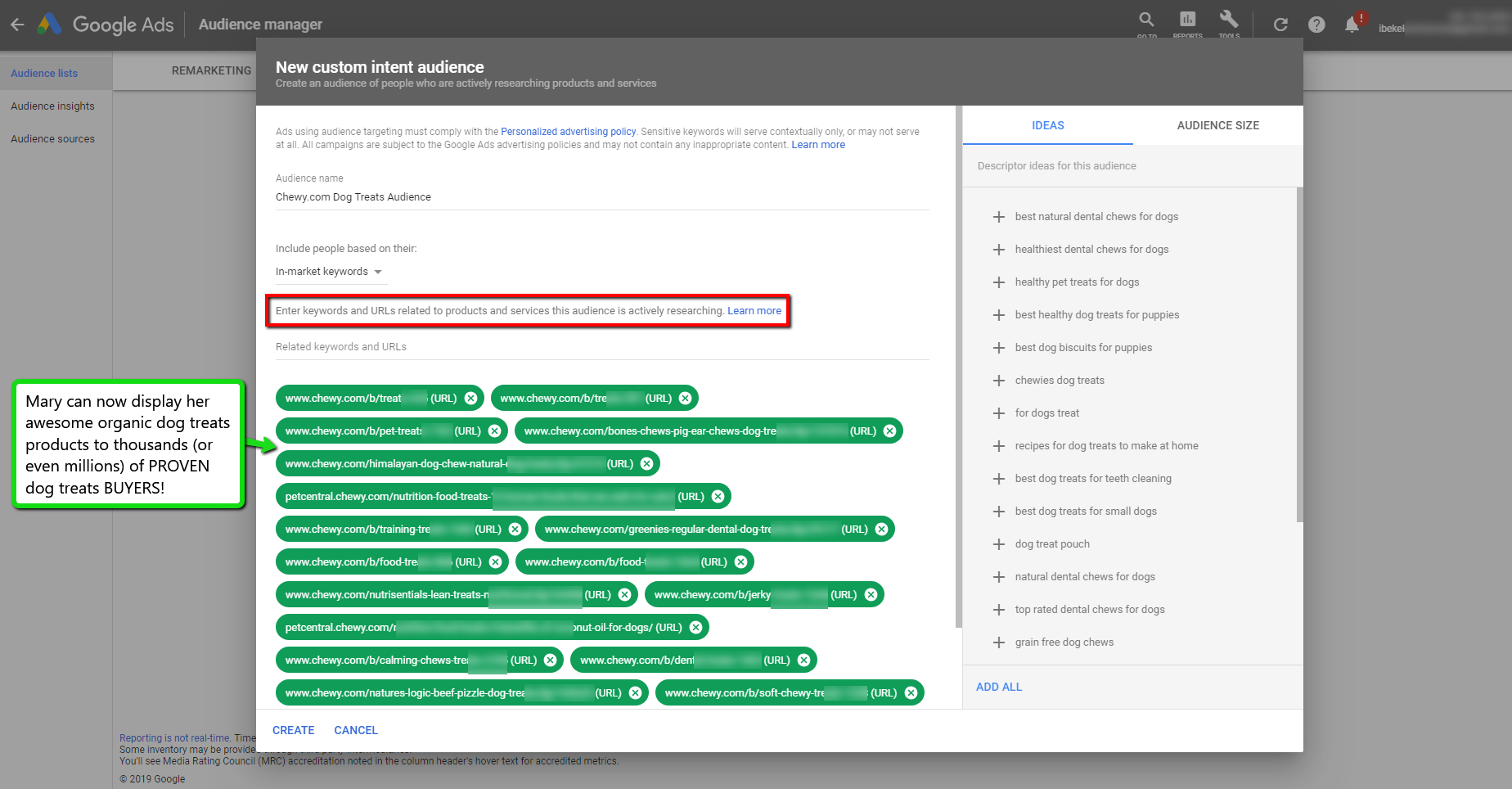
Below is an example of what Mary’s custom intent audience list could look like.
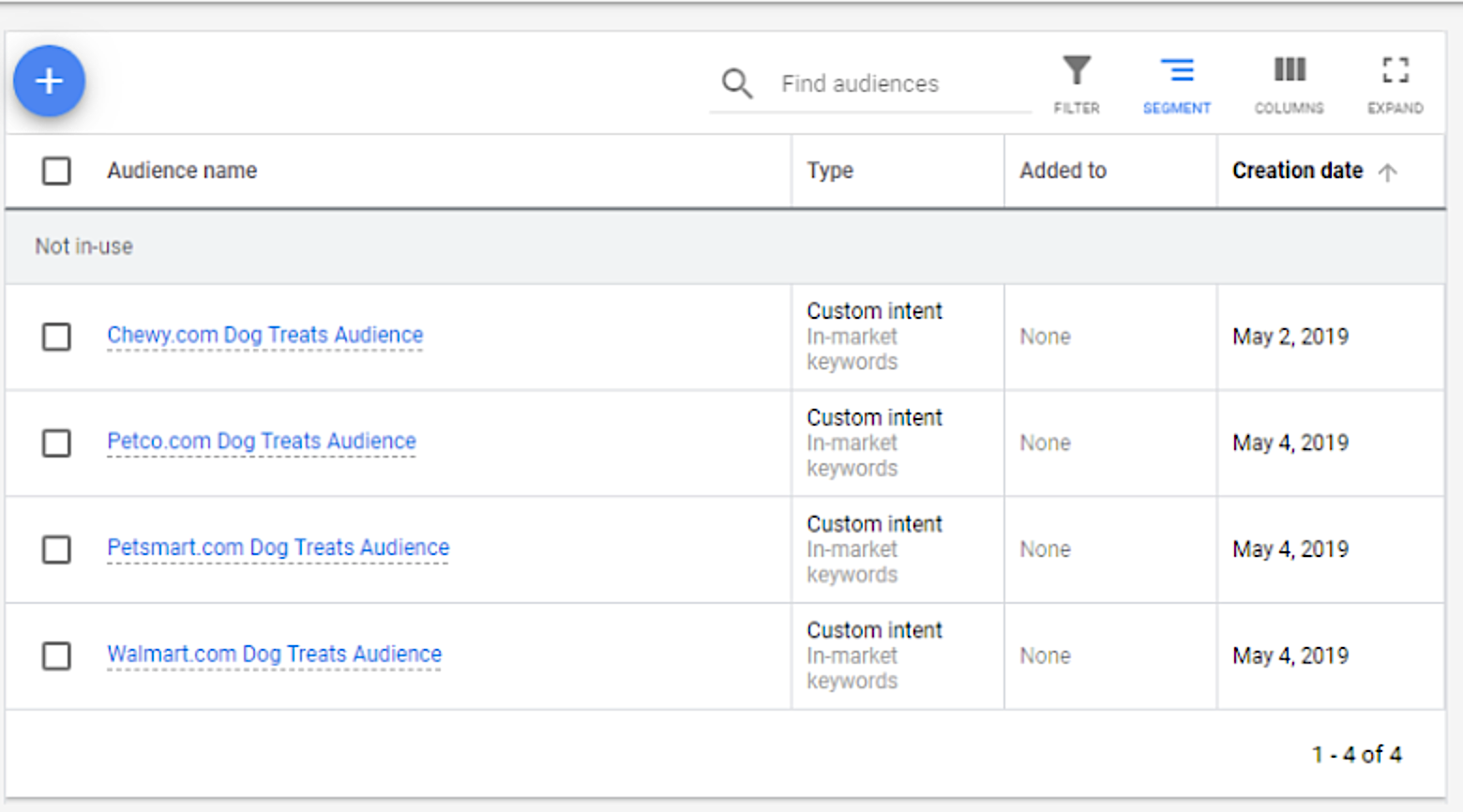
Starting to see the picture?
Now, Mary can focus on selling her products to dog treats BUYERS only. And as an extra bonus, she can also see which brands are sending her the most customers. Who knows, with a presentation of her targeting strategy, it may force one of those top dog brands to carry Mary’s products in the future (or acquire her business).
If you are wondering whether or not this type of targeting strategy is “fair,” all I can say is it is a dog eat dog world out there (pun intended).
3. Custom Intent Audiences Give Brands a Rare Opportunity to Be Thought Leaders Around a Given Topic
When it comes to thought leadership around specific industry topics, most would argue that SEO and content marketing is the best way to do it. But while this is true, there is an even better (and faster) way—custom intent audiences.
SEO is a long-term play with massive ROI which every business worth its salt should have. But ranking on the first page of search results, even with the best content and optimization practice, takes about 2–6 months on average (and depending on competition, can take much longer).
So, how can businesses reach Google searchers without waiting eons to rank? You guessed it...
Custom Intent Audiences + Responsive Display Ads (more on this point later).
By utilizing the URLs of the websites already on the first page of Google, you can reach those same searchers in a cost-effective way through a custom Intent display campaign (without having to wait to rank organically). And, send those same searchers to your article while building a retargeting list to use later in other marketing channels.
See it as a short-cut to success, because it truly is.
As an added benefit, this strategy can also help the article you create rank faster on the SERPs because you are supplying the search engine algorithms with user engagement signals about your piece of content which could boost its position on the search result.
Since these are high-intent searchers currently researching the topic you are promoting, they are more likely to spend more time on your site, which is a GREAT SEO ranking factor.
An example:
Let’s assume we just launched a marketing automation SaaS product, and we want to be known as thought leaders for the topic “marketing automation”.
We begin by getting the top URLs currently ranking on the first page of Google for that keyword. Below are some of those URLs:

Now, we can hop over to Google Ads and create a custom intent audience with those URLs so we could reach everyone visiting those pages with our targeted display ads (remember, our display ad creative and destination URL will be centered around marketing automation).
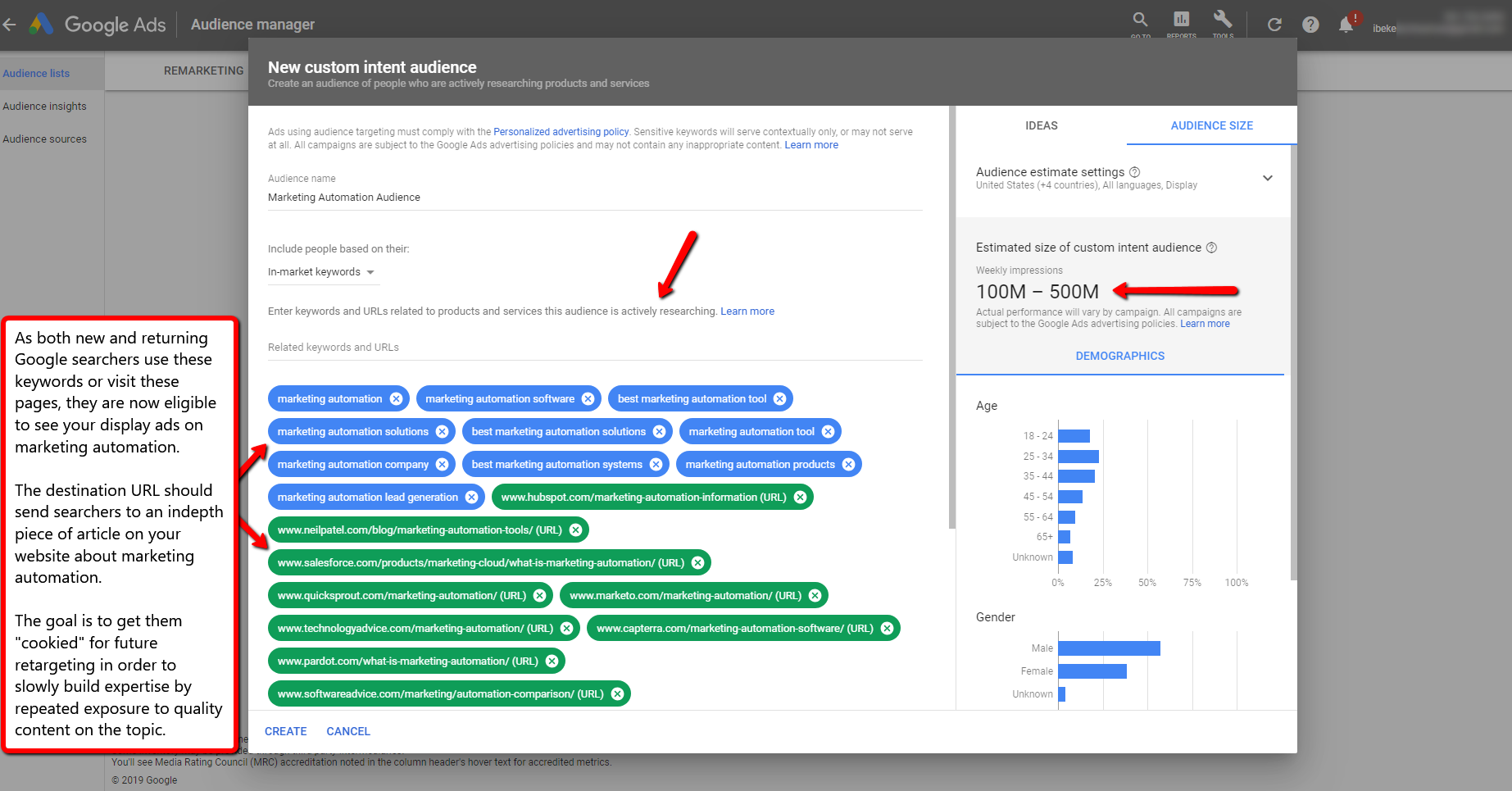
NOTE: Before this campaign is launched, a company’s analytics team should already have retargeting lists created on Google, Facebook, and LinkedIn. This is very important because the goal is to continue the conversation with these same people on multiple marketing channels. The naming convention for each retargeting list on each platform could be something like “Marketing Automation Audience”.
BONUS TIP: By implementing the LinkedIn Insight Tag on a website and utilizing LinkedIn Website Demographics, marketers can also see the job titles and company names of these Google Searchers!
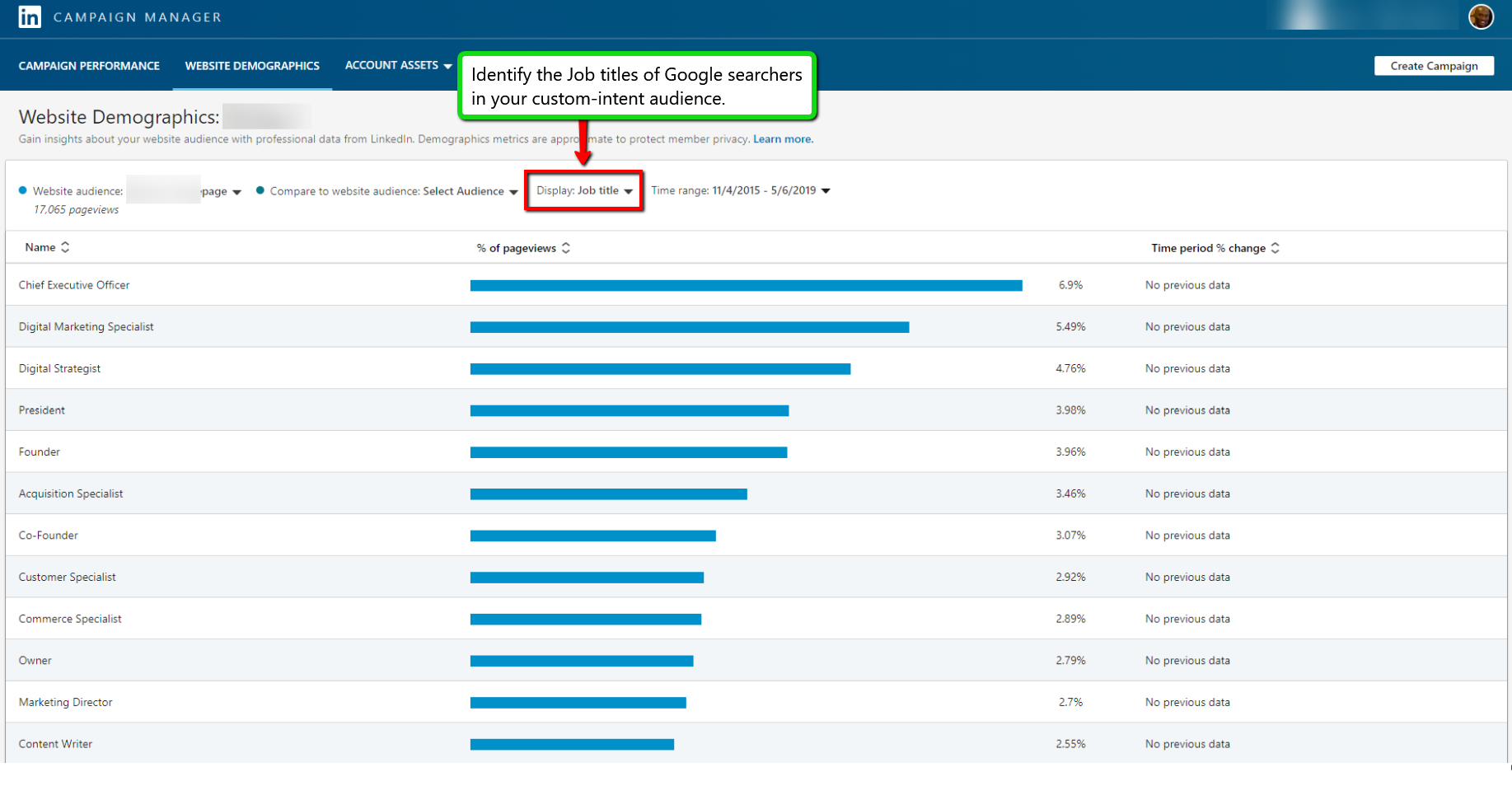
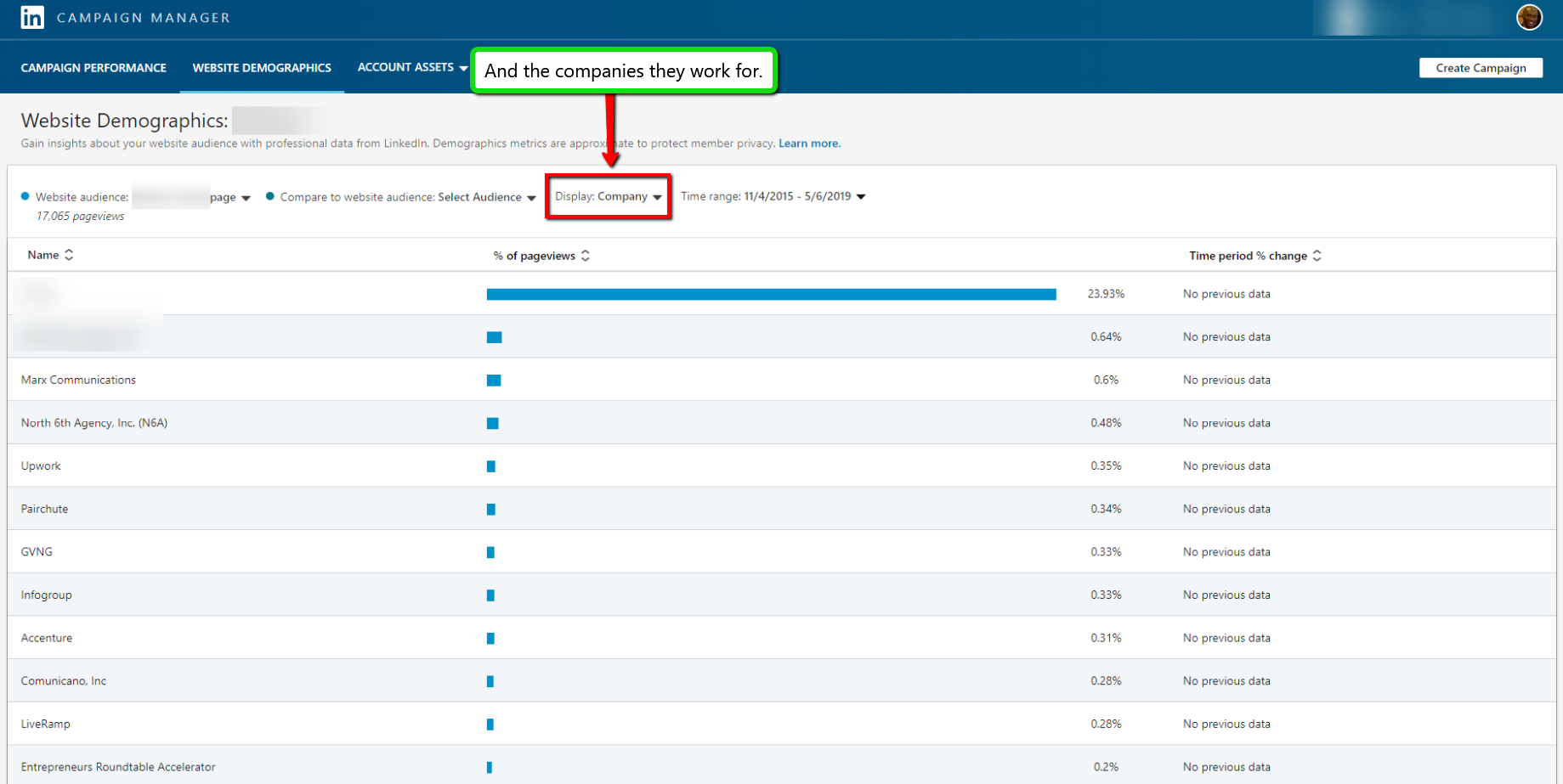
This insight can help fuel account-based marketing initiatives or simply assist in tailoring future re-marketing content to be hyper-relevant to specific business professionals.
Notice how we have moved from reaching people researching specific topics on Google to identifying their job titles and the companies they work for?
If you are in B2B sales, do you think your sales teammates would like to get their hands on this data?
You better believe it! This is high-quality intent-data right here; this is what the whole buzz of sales & marketing alignment is all about.
- Sales provide Marketing with customer feedback and the companies (aka “accounts”) they wish to go after.
- Marketing can implement data-driven marketing strategies as explained above and use insights from analytics to identify potential “MQAs” (Marketing Qualified Accounts).
Strategy Summary:
- Grow a retargeting list on Google, Facebook, and LinkedIn through a custom intent display campaign.
- Provide those audiences with quality content across platforms WHILE also checking analytics to see the companies and buyer personas engaging with the content (through the use of LinkedIn Website Demographics).
- Slowly build topic authority in the minds of their prospects while also shortening sales cycles, accelerating pipelines, and identifying new key accounts at scale.
4. Custom Intent Audiences Reduce Waste in Ad Spend
Another benefit of utilizing custom Intent audiences is it reduces waste; this is where most marketers get it wrong.
The fact that a group of people has Digital Marketing on their job title and an interest in website analytics does not mean they are currently in-market for a website analytics tool. Therefore, an advertiser would be wasting precious ad dollars showing them ads.
Custom Intent audiences will give you the opportunity to address only potential customers using relevant creatives and offers.
Right audience + Right creative + Right content = Higher Performance
Since ads are only being served to specific cohorts of people interested in a given topic, there is no waste in ad impressions which often happens when targeting broad categories like interests, job titles, industries, etc.
5. Custom Intent Audience Targeting is Cheaper
One “drawback” of search ads is that, due to their high-intent targeting capabilities, the average cost per click is usually very high.
With custom intent audience campaigns, cost per click is A LOT cheaper while still targeting the same high-intent searchers.
TIP: When creating a display ad campaign with custom intent audiences, use the responsive display ad feature; this tends to get more impressions, clicks, and higher CTR at a lower cost compared to static image ads.
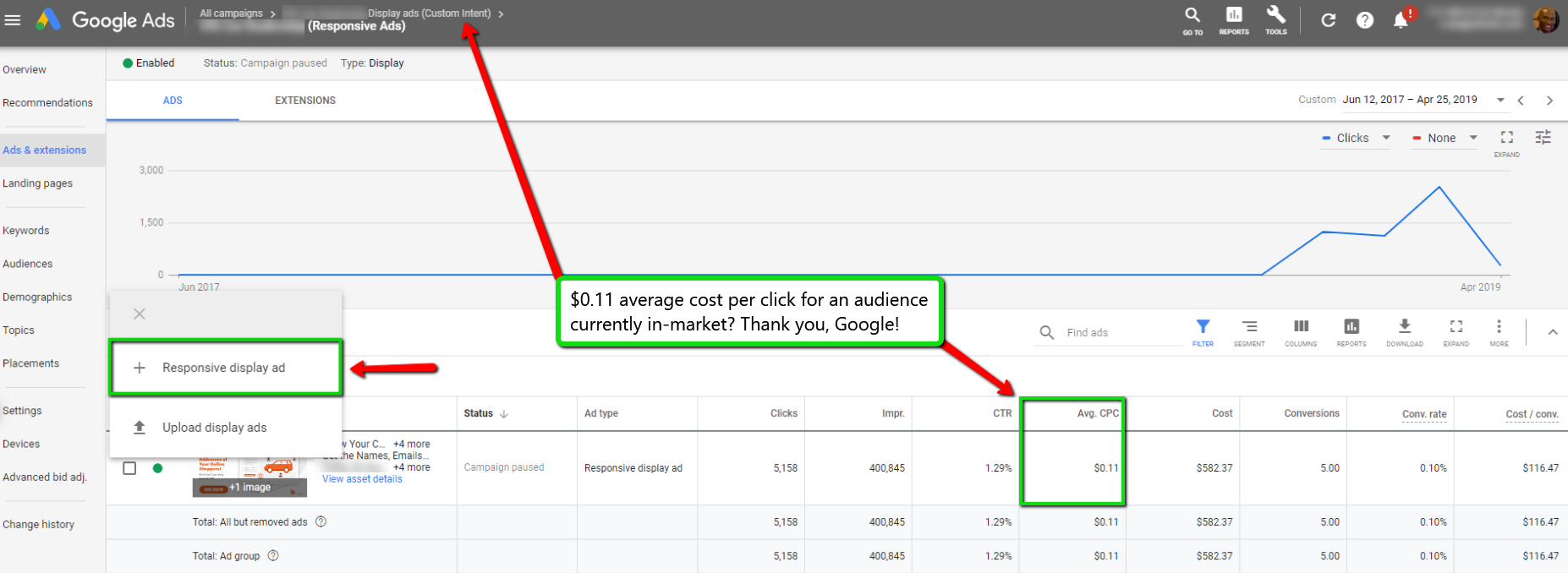
4 Multi-channel Marketing Playbooks You Can Implement Right Now Utilizing Custom Intent Audiences + Retargeting
Now that we have covered the power of custom intent audiences let’s run through some custom playbooks; this is where the real fun begins!
1. Custom Intent Audiences + Remarketing List for Search Ads (RLSA)
RLSA is a Google Ads retargeting strategy that tailors search campaigns to previous website visitors. For example, a shopper adds a Gucci wristwatch to their shopping cart but abandons their order. Two weeks later, the same visitor goes to Google and searches for “Gucci watches cheapest price”, and your ad appears in the first ad position saying, “Affordable Gucci Watch | Save An Extra $75 - Today Only | Your Brand Name”.
Because this customer has visited your website before, they are more likely to click on your ad, especially if competing advertisers are not offering discounts or promotions on their ads.
By combining custom intent audiences with RLSA, marketers can reach high-intent prospects already exposed to their brand—who are at the decision stage of the buying journey.
Let’s run through another playbook.
For this example, let’s assume we recently launched a new Account-Based Marketing software.
- First, we create an “Account-Based Marketing Audience” retargeting list inside Google Ads to “cookie” people who arrive through our custom intent display ad.
- Next, we create a custom intent audience using keywords and URLs of pages ranking on the first page of Google for various keywords on account-based marketing.
- We then launch a custom intent audience display campaign directing visitors to a detailed and actionable piece of content on account-based marketing that strategically mentions our ABM software’s unique features within the content.
- At the same time, we also launch an RLSA Google search campaign using a broad match modifier search phrase +account +based +marketing +software.
This means, whenever someone inside our “Account-Based Marketing Audience” retargeting list performs a Google search in the future for any phrase related to account-based marketing software (e.g., best account-based marketing software), our ad shows up at the top ad position with a direct response offer promoting our ABM software.
2. Custom Intent Audiences + Facebook Video Ads
When it comes to social media advertising, Facebook has the best interest-based targeting option on the market. By layering in a custom intent audience from Google with Facebook retargeting, you are no longer “disrupting” a user’s social media experience by targeting just their interest. Rather, you are continuing the conversation they started on Google.
There are various ad formats to choose from on Facebook. However, I believe utilizing video creatives gives the best results. Here are 5 reasons why:
- Facebook’s algorithm is optimized to ensure video content gets more views (due to the rise of video consumption by users. Plus, videos keep people on Facebook longer).
- Video views are way cheaper than link clicks from text and image ads and are just as (if not more) effective at converting prospects into customers.
- Videos typically get higher engagements and help advertisers emotionally connect with people. Add to that, higher engagements improve Facebook’s relevance score, which results in an even cheaper cost per view (all the more reason to utilize Google’s custom intent audience from the very beginning! Since we are using intent data from Google, people are more likely to engage with the video content on Facebook, resulting in cheaper ad costs and higher ROAS! This combination makes this strategy more powerful than regular Facebook interest-based targeting!)
- Video gives personality and a face to a brand.
- And by far the best benefit, Facebook video ads give advertisers the ability to create custom audiences of people who watch specific lengths of a video (i.e., 3 seconds, 10 seconds, 25%, 50%, 75%, and 95%).
Why is this important?
It helps advertisers identify and retarget specific cohorts of people most likely to convert into paying customers. The more time someone spends watching a video, the higher their intent to purchase.
Below is how you create a custom audience of video watchers on Facebook.
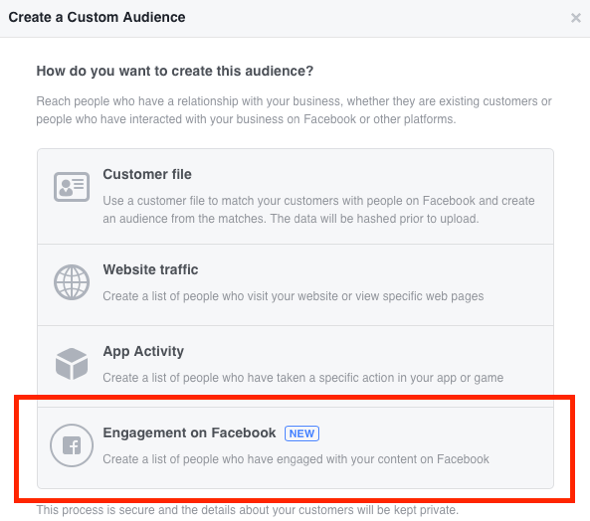
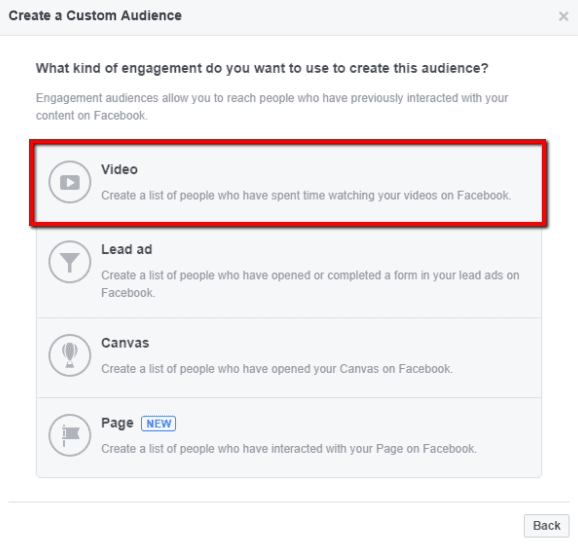
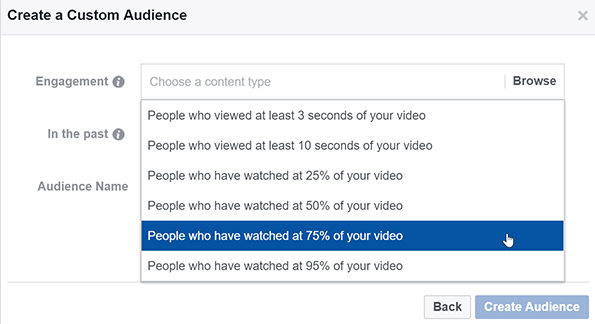
When you combine this with the fact these are the very same people researching on Google for a specific topic, and you can start to see how this playbook can become extremely dangerous.
Strategy for Facebook and Google:
- Launch a custom intent audience display campaign through Google. Prior to launch, ensure that a Facebook pixel has been installed on the website and that a retargeting list has been created for that same audience on Facebook.
- As these high-intent searchers click on the display ad to consume content, they are being added to the Facebook retargeting list.
- Next, create a Facebook video ad using the retargeting list. This video ad should share even more helpful free content related to the topic they previously researched on Google.
- Finally, build a custom audience on Facebook of video watchers (say of people who watched 95% of your video—these are your “super-hot” prospects), and promote a direct response offer to them.
For the video watchers who watched just 10 seconds—75% of your video, use different customer testimonial videos to nudge them to convert.
3. Custom Intent Audiences + YouTube TrueView for Action
With TrueView for Action + custom intent audience, marketers can reach people on YouTube after they perform a search on Google for a particular keyword.

Here are a few playbooks you can run:
- Use your competitors’ brand name, brand name + product/service, and brand name + product + location as keywords for your custom intent audience. This is an inexpensive way of increasing brand awareness with video while advertising to potential customers (who may not know your business exists) currently visiting your competitors’ website.
It is extremely cheap compared to bidding directly for your competitors brand names on Google search. Plus, it is also a “sneaky way” of targeting their visitors without them seeing your ads on Google search results for their brand name.
- Retarget searchers using “how to” keywords and provide them with helpful video content next time they go on YouTube (an easy way to get YouTube subscribers and build topic authority while staying relevant).
- Retarget people researching specific products on Google the next time they go on YouTube using short product demos or customer testimonials about that same or similar product and offer a good discount with a strong CTA.
![]()
4. Custom Intent Audiences + LinkedIn Sponsored InMail
I saved my best for last!
If you are in B2B sales, you will love this playbook because it enables sales teams to have a more successful outreach. See it as an upgrade from sending unsolicited messages to a “list of contacts”(aka cold emailing).
Like the account-based marketing playbook above, marketing teams can combine traffic from both custom intent display campaign and paid search ads to create a retargeting list on LinkedIn—for people in-market for a particular software or service.
As the LinkedIn retargeting list starts to grow, marketers can create a Sponsored InMail campaign (using their sales teammates as senders) targeting those individuals in their LinkedIn inbox while paying as little as $0.20 per send!
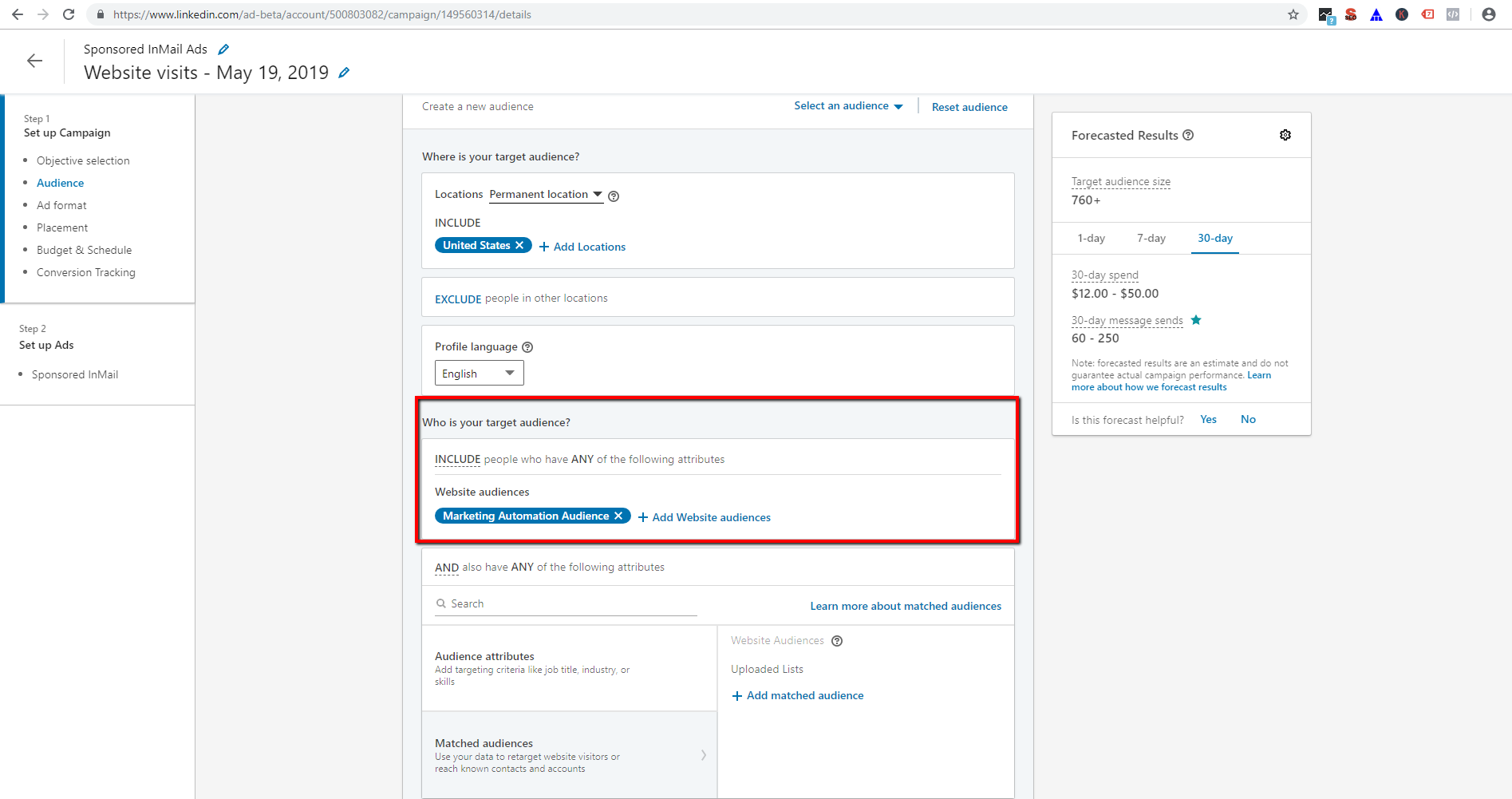
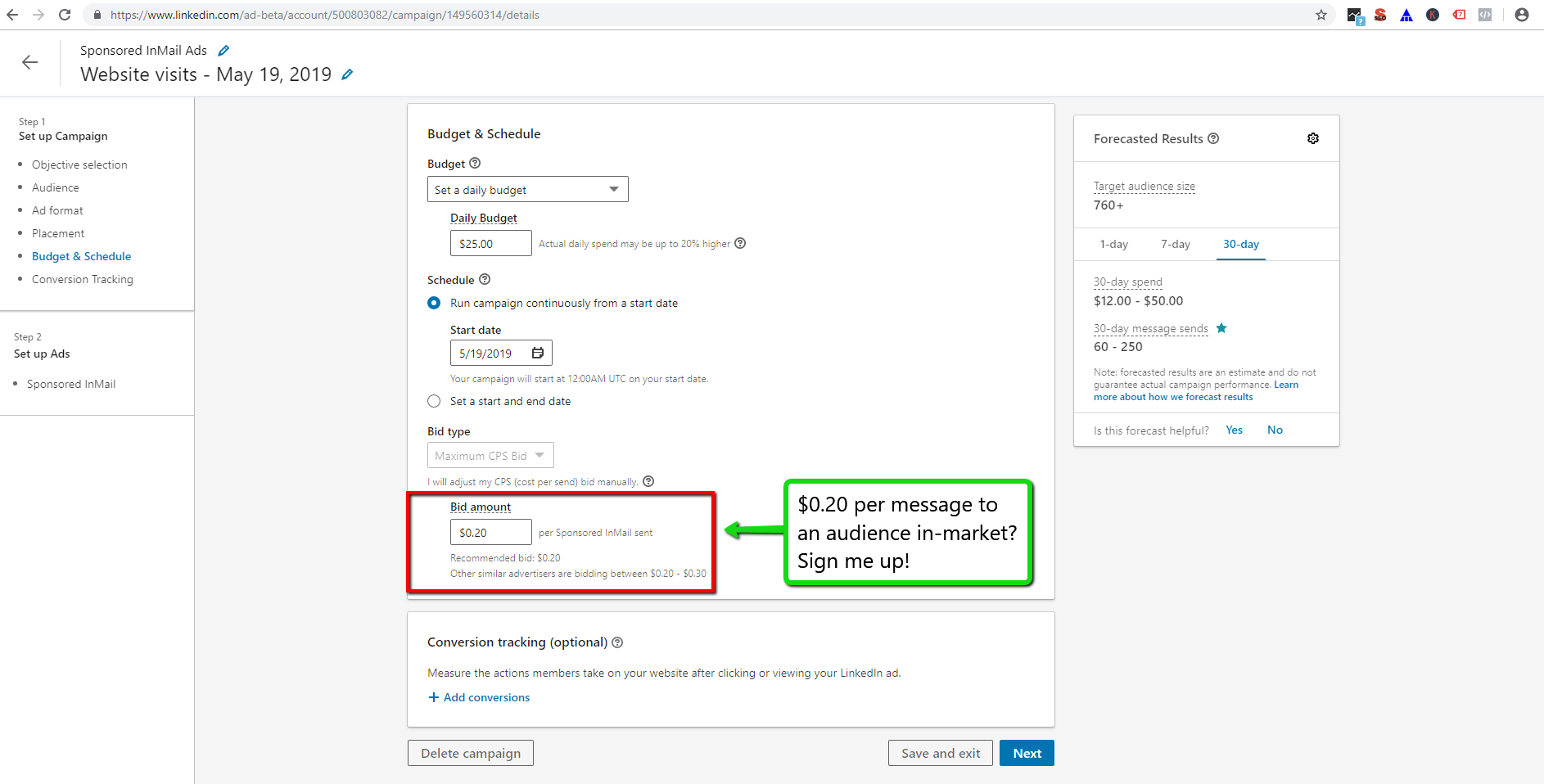
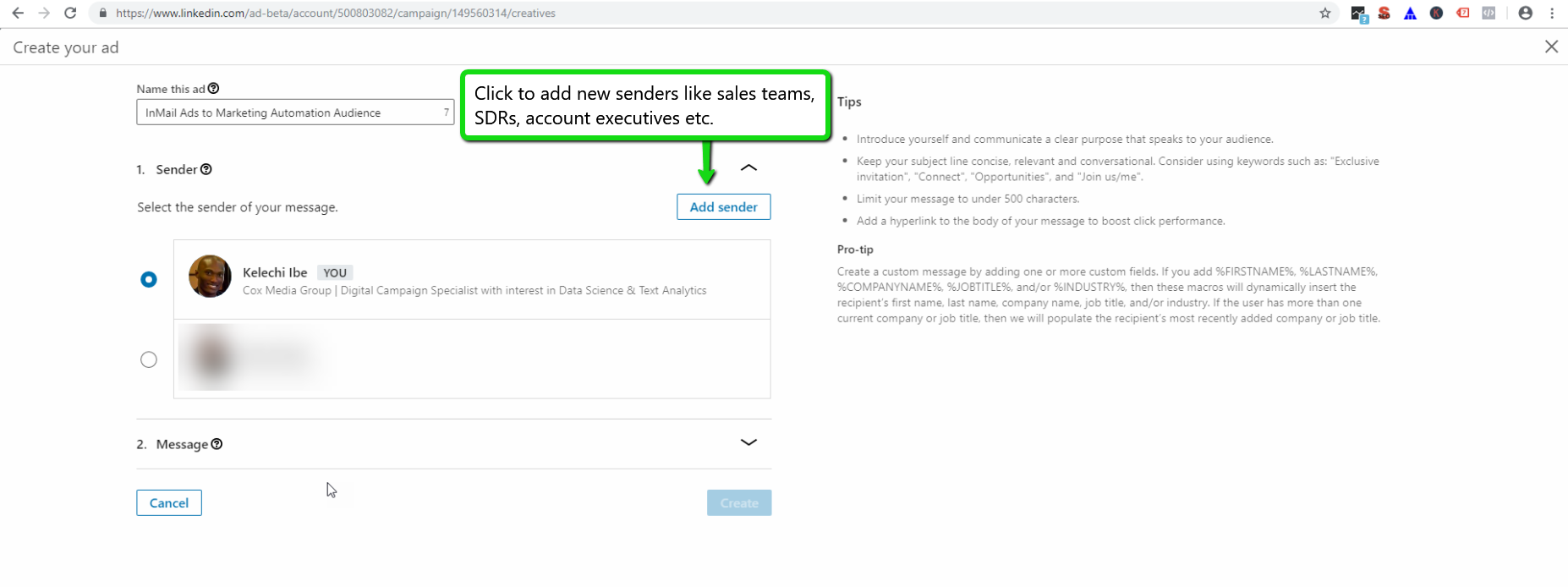
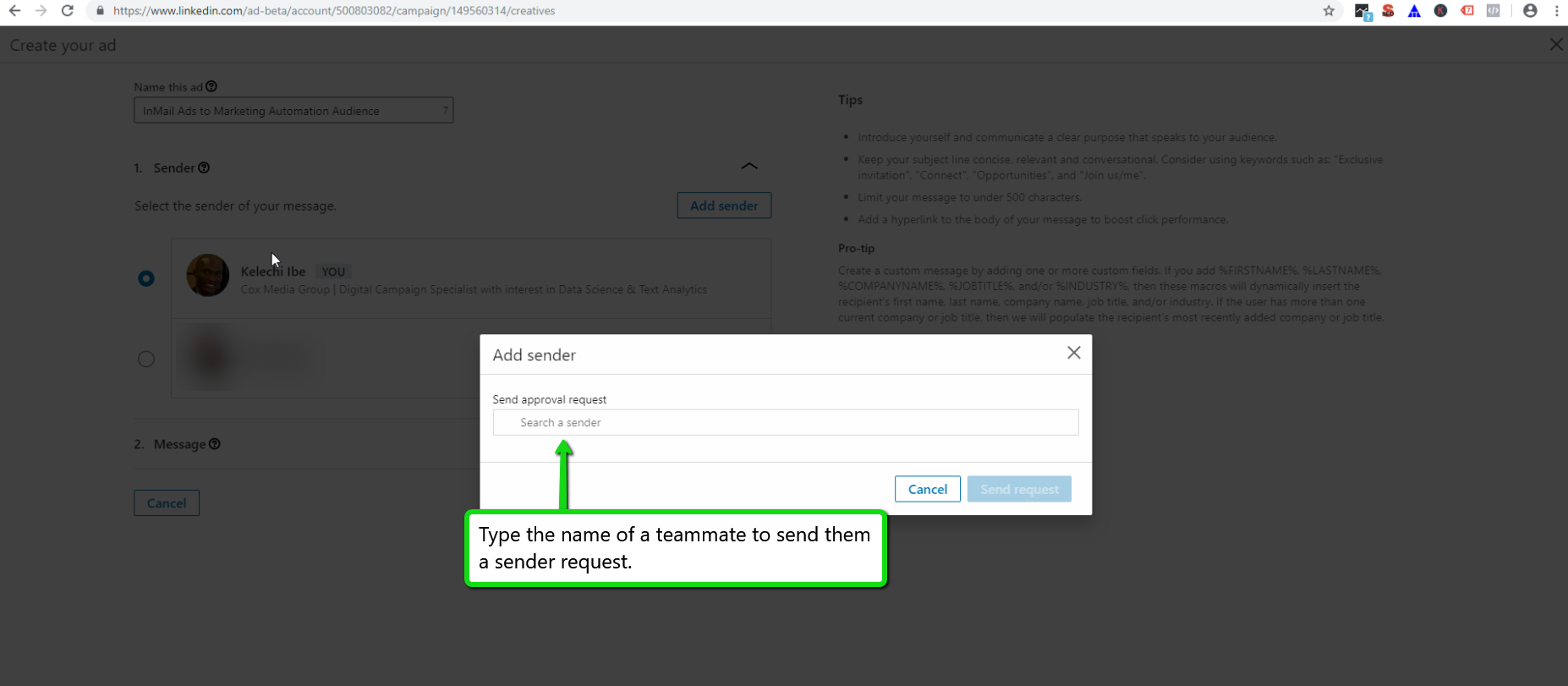
The best part about LinkedIn’s Sponsored InMail is that messages enter a user’s inbox only when they are logged in and active on LinkedIn; this means your message will have a near 99% open rate. This number is higher than any traditional email marketing campaign!
This playbook is great for account-based marketing initiatives and for organizations whose sales strategy is constructed for sales teams to sell to specific verticals. Each sales rep can be used as senders for the relevant in-market audience segment.
As you can imagine, this beats compiling a list of unknown contacts and sending them a cold email because you are simply continuing a conversation on LinkedIn that they started on Google; you are relevant.
To Sum Up
In closing, there are many more data-driven techniques hiding within platforms and marketing channels that I didn’t cover (like creating a custom intent audience using your competitor’s visitor traffic and sending them a Sponsored InMail to win them over).
The key is knowing how to leverage first-party website visit data to your advantage. Lastly, as the saying goes:
With great power comes great responsibility.
Use these custom intent audience strategies with care, because they are that powerful.
Over to you
Have you launched a custom intent audience campaign before? If not, are you willing to try them now? What other custom intent audience strategies can you think of?
Please share your thoughts and comments below. I will be sure to join the conversation!

